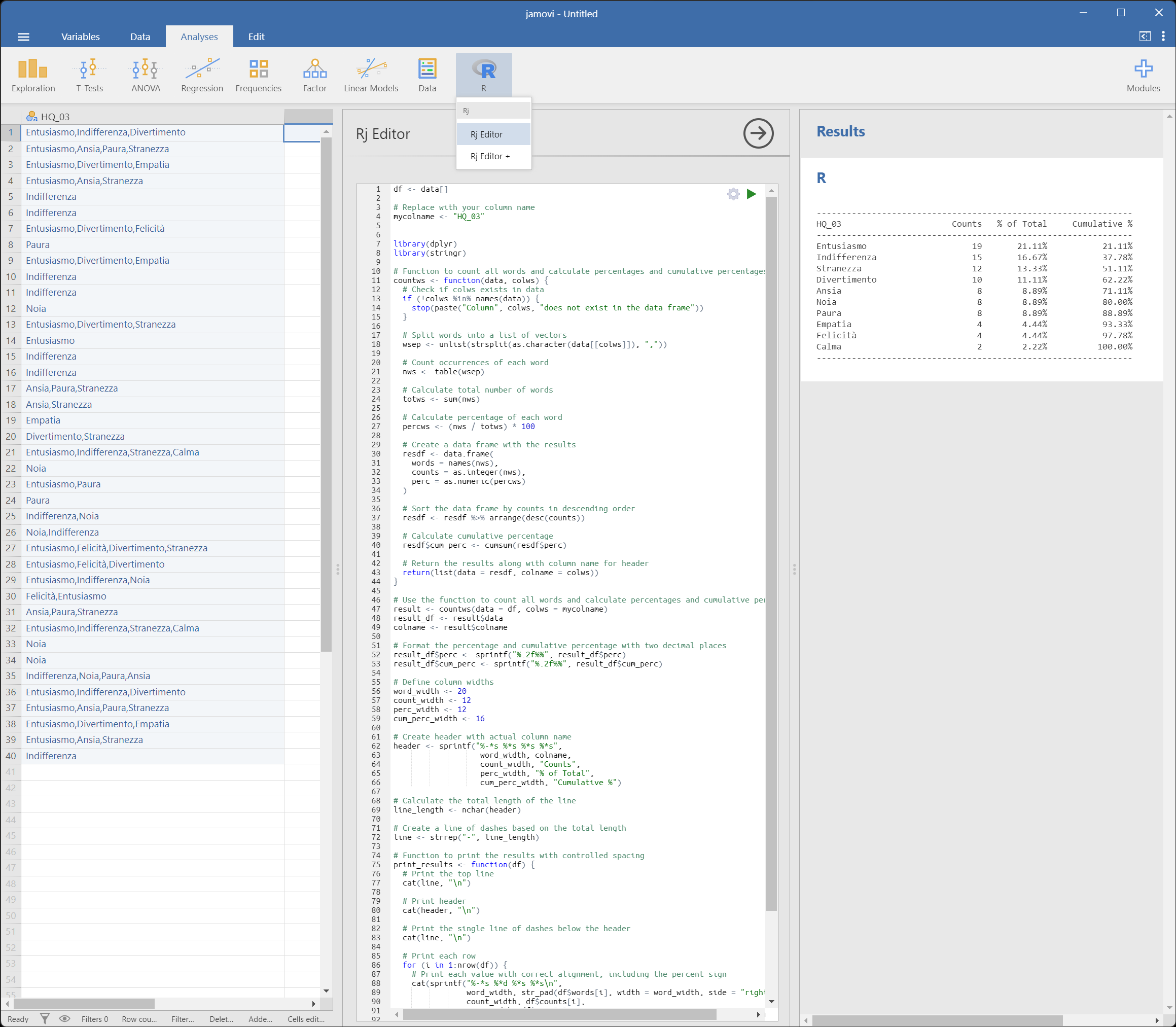Hey Isabel,
I'll give you a small R script to use with the Rj module that you find in the jamovi library, if you don't already know it.
Code: Select all
df <- data[]
# Replace with your column name
mycolname <- "HQ_03"
library(dplyr)
library(stringr)
# Function to count all words and calculate percentages and cumulative percentages
countws <- function(data, colws) {
# Check if colws exists in data
if (!colws %in% names(data)) {
stop(paste("Column", colws, "does not exist in the data frame"))
}
# Split words into a list of vectors
wsep <- unlist(strsplit(as.character(data[[colws]]), ","))
# Count occurrences of each word
nws <- table(wsep)
# Calculate total number of words
totws <- sum(nws)
# Calculate percentage of each word
percws <- (nws / totws) * 100
# Create a data frame with the results
resdf <- data.frame(
words = names(nws),
counts = as.integer(nws),
perc = as.numeric(percws)
)
# Sort the data frame by counts in descending order
resdf <- resdf %>% arrange(desc(counts))
# Calculate cumulative percentage
resdf$cum_perc <- cumsum(resdf$perc)
# Return the results along with column name for header
return(list(data = resdf, colname = colws))
}
# Use the function to count all words and calculate percentages and cumulative percentages
result <- countws(data = df, colws = mycolname)
result_df <- result$data
colname <- result$colname
# Format the percentage and cumulative percentage with two decimal places
result_df$perc <- sprintf("%.2f%%", result_df$perc)
result_df$cum_perc <- sprintf("%.2f%%", result_df$cum_perc)
# Define column widths
word_width <- 20
count_width <- 12
perc_width <- 12
cum_perc_width <- 16
# Create header with actual column name
header <- sprintf("%-*s %*s %*s %*s",
word_width, colname,
count_width, "Counts",
perc_width, "% of Total",
cum_perc_width, "Cumulative %")
# Calculate the total length of the line
line_length <- nchar(header)
# Create a line of dashes based on the total length
line <- strrep("-", line_length)
# Function to print the results with controlled spacing
print_results <- function(df) {
# Print the top line
cat(line, "\n")
# Print header
cat(header, "\n")
# Print the single line of dashes below the header
cat(line, "\n")
# Print each row
for (i in 1:nrow(df)) {
# Print each value with correct alignment, including the percent sign
cat(sprintf("%-*s %*d %*s %*s\n",
word_width, str_pad(df$words[i], width = word_width, side = "right"),
count_width, df$counts[i],
perc_width, df$perc[i],
cum_perc_width, df$cum_perc[i]))
}
# Print the bottom line
cat(line, "\n")
}
# Call the print function
print_results(result_df)
It's my possible answer to your question, which could also be useful to others.
It could probably be accessible differently in the future, but for now you can copy the code that I leave and paste it into the Rj text editor.
Running it should give you what you're looking for.
The screenshot that I attach should clarify what it does.

- Rj_example.png (329.52 KiB) Viewed 14136 times
In the example there is a worksheet with a single column and a few cases (hot and laziness), which could represent your variable of interest.
I put the same name as your variable, but if you have a different name to try, in the R script you can replace the one I used (4th line of the R script).
Cheers,
Maurizio
https://www.jamovi.org/about.html